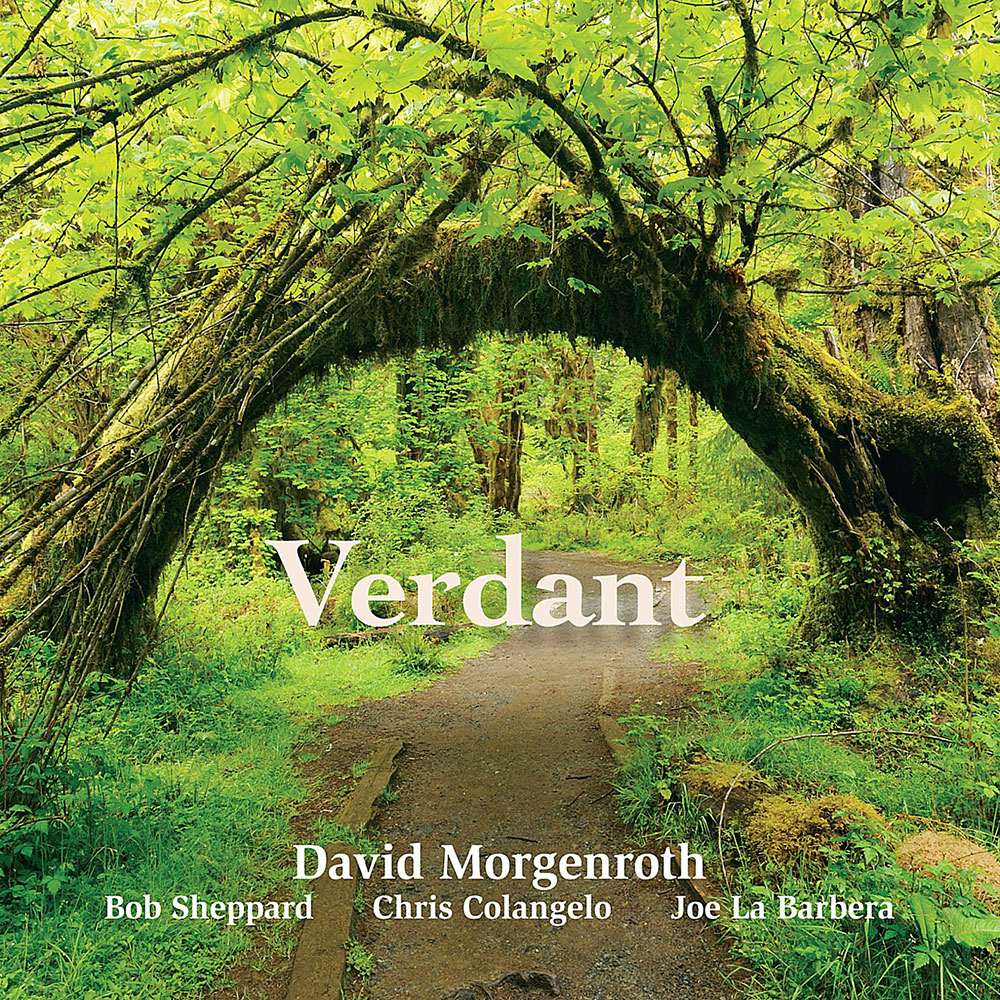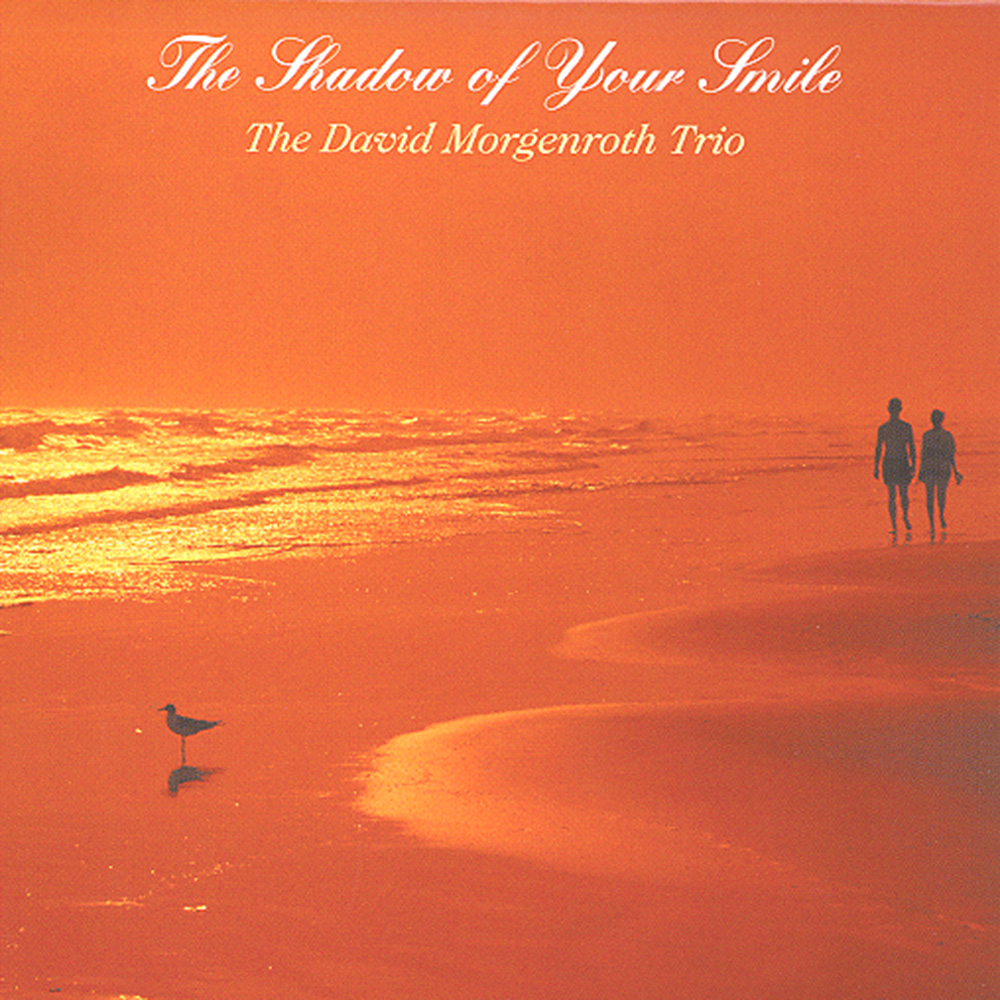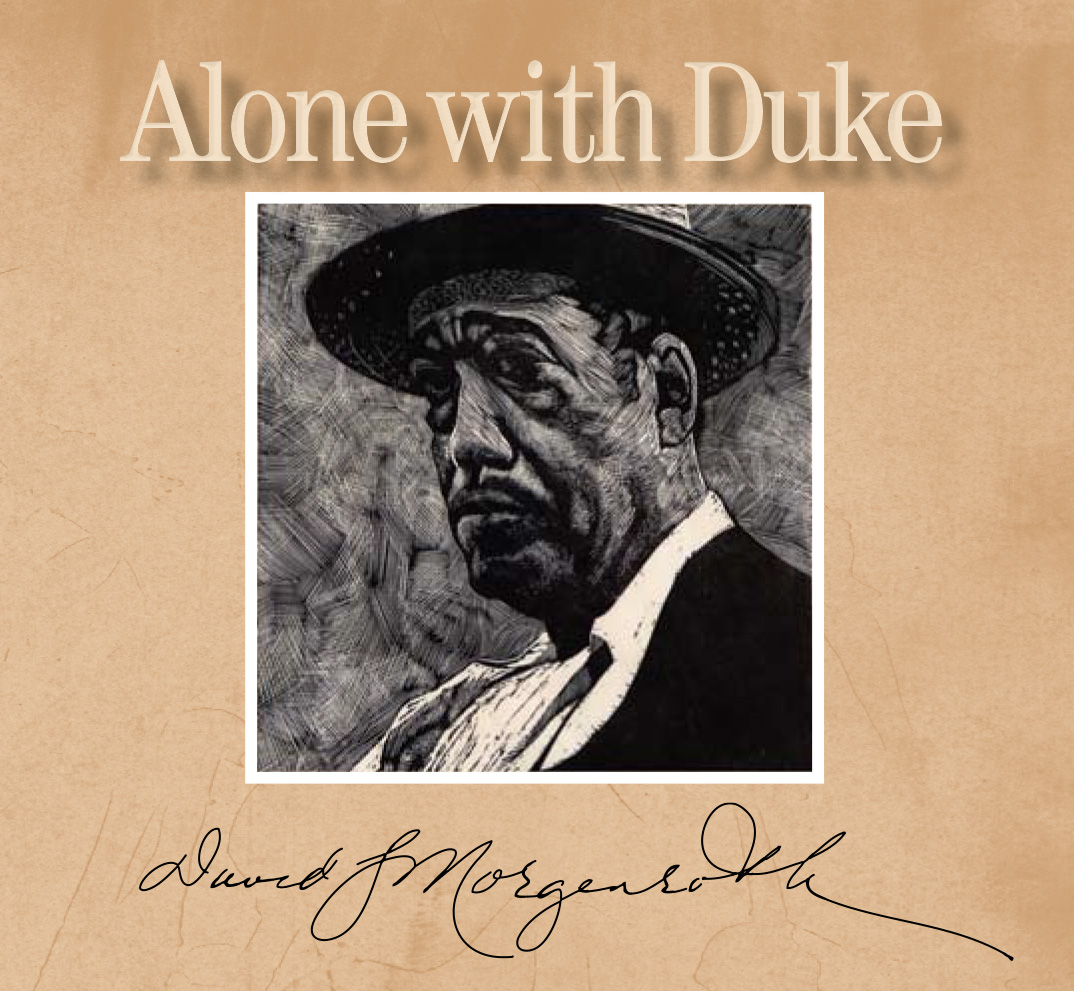VERDANT

- Barbara
- Counterplot
- ¡Macanudo!
- Estate
- It’s Magic
- If You Could See Me Now
- Meridian
- Verdant
David Morgenroth : Piano / Bob Sheppard : Soprano & Tenor Saxophones / Chris Colangelo : Bass / Joe La Barbera : Drums
His last release, Alone With Duke (2009), allowed pianist David Morgenroth to construct his own little musical universe as it relates to the music of Duke Ellington. In the solo format, he called the shots--dealing out melody, harmony and rhythm cards—all from the same hand. It was an impressive display of keyboard mastery and a comprehensive artistic body-scan. If it was ever in doubt, the Montana native showed that he could handily make a place for himself in the jazz capitals of either coast.
In this follow-up effort, Morgenroth returned to Andy Waterman’s Umbrella Studios the following year. The album before you is a piggyback production of sorts; David came to Los Angeles to record a trio album of Johnny Mandel tunes for a Japanese label. He was in the company of some of the best and most accomplished Southern California jazz players, so Morgenroth used the occasional to cut a program weighted toward his originals.
His collaborators are standard-bearers for present-day L.A. jazz. Tenor and soprano saxophonist Bob Sheppard’s ease with all kinds of material has earned him a top berth in the Hollywood studios. He has a superlative facility that gives his improvisations the carefree air of someone whistling them on the way home from work.
Philadelphia-reared bassist Chris Colangelo is a propulsive player. “This music has to feel,” he holds, “as if it’s leaning forward. If it’s not, it can be perceived as dragging.” A key to Colangelo’s musical DNA is his respect for the way bass master Ron Carter functioned in the Miles Davis Quintet of the 1960s. “Everybody went for it in that group,” Chris notes. “That’s great, but somebody’s got to stay home and keep the lights on. That was Ron’s role, and he performed it beautifully.”
Few drummers have the skillset that drummer Joe LaBarbera brings to the trap set. Whether he’s driving a big band, swinging and shading a trio or sight-reading a singer’s nuanced charts on a nightclub gig, LaBarbera is one of jazz’s greatest contemporary practitioners.
Though Morgenroth lived in New York for six years and studied with the great pianist Fred Hersch, he’s also spent a fair amount of time in SoCal. He loves the East Coast energy but has found a kinship with West Coast players. “Musically,” David believes, “I think that the L.A. cats are just as heavy, but they’re more relaxed. They’re extremely serious about music but they certainly have a more relaxed approach to life. I like that a lot.”
Tadd Dameron’s “If You Could See Me Now” is something David used to play with clarinetist Buddy DeFranco. Sheppard’s tenor is its most rhapsodic on this lush ballad, though his soprano is positively creamy on “Barbara.” The big sound that Colangelo achieves is captured with just one microphone—and no pickup. And hear LaBarbera’s gently lapping cymbal waves on the title tune.
David’s compositions come from a necessity of expression. “I don’t do it every day,” he says, “like I play piano.” Melody is primary to his pieces, exemplified by the sprightly “Barbara,” written for his wife, museum director and former professional clarinetist Barbara Koostra. The rhythmic challenges of “¡Macanudo!” are one example of what prompted LaBarbera to heartily commend Morgenroth for his compositions and arranging.
Morgenroth reflects many of the important pianos stylists of the past 50 years. His strong lyrical quality denotes his love for the classic Bill Evans Trio of bassist Scott LaFaro and drummer Paul Motian. The hell-bent swing of “Counterpart” recalls the dynamic tension of Horace Silver and Red Garland-led rhythm sections. While David’s solos sparkle, his comping indicates that he takes obvious joy as one third of a cooking rhythm section. By contrast, he confesses that the very personal “Meridian” comes from “some deep, dark place inside of me. There’s a certain edge, a certain danger to it.” As Joe Zawinul could express grittiness and beauty in the same piece, so too can Morgenroth hit to either field.
Bruno Martino’s sensual “Estate” is an old favorite; aside from his longtime fondness for Brazilian music, David loves the pedal points in the tune. The floating “Verdant” is rife with harmonic implications without strict traffic signs. Morgenroth’s classical music grounding underpins his playing. It’s full of the kind of lyrical sunshine and playful execution that are hallmarks of this very accomplished pianist.
Prepare to be moved.
- Kirk Silsbee, Liner notes to "Verdant" by David Morgenroth
Recorded by Andy Waterman at Umbrella Media, Chatsworth, CA; edited and mastered byGil Stober, Peak Recording, Bozeman, MT; arranged and produced by David Morgenroth, 2014.
THE SHADOW OF YOUR SMILE

- Close Enough for Love
- The Shadow of Your Smile
- Where Do You Start?
- Emily
- Don't Look Back
- Suicide Is Painless (Theme from M*A*S*H)
- The Shining Sea
- A Time for Love
- I've Been Around
- Little Did I Dream
- Vacation from the Blues (From "I Want to Live")
- Take Me Home
- The Shadow of Your Smile
David Morgenroth : Piano, Arrangement/ Chris Colangelo : Bass / Joe La Barbera : Drums (except on 13) / Kendall Key : Drums (on 13) / Eden Atwood : Vocals (on 13)
"The Shadow of Your Smile" is a celebration in jazz of the music of Johnny Mandel. It features David Morgenroth, piano; Chris Colangelo, bass; and Joe LaBarbara, drums. Eden Atwood, vocalist, appears on one track. This CD was made for SSJ Records and was designed for the Japanese market.
Recorded and Mastered May 12 and 13 & June 15, 2010 by Andy Waterman at Umbrella Media, Chatsworth, CA
ALONE WITH DUKE

- Just Squeeze Me (But Please Don’t Tease Me) Duke Ellington, Lee Gaines
- Cotton Tail Duke Ellington
- Come Sunday Duke Ellington
- I’m Just a Lucky So-and-So Duke Ellington, Mack David
-
Love You Madly Duke Ellington
- Melancholia Duke Ellington
- Mood Indigo Duke Ellington, Irving Mills, Albany Bigard
- It Don’t Mean a Thing (If It Ain’t Got That Swing) Duke Ellington, Irving Mills
- Prelude to a Kiss Duke Ellington, Irving Mills, Irving Gordon
-
In a Sentimental Mood Duke Ellington
- Jump for Joy Duke Ellington, Paul Francis Webster, Sid Kuller
- C Jam Blues Duke Ellington
- Single Petal of a Rose Duke Ellington
David Morgenroth : Piano, Arrangement
Of the all the musical configurations jazz pianists might work in, the solo format is the most demanding. Keyboardists have to generate all three musical elements—melody, harmony and rhythm—all by themselves. Like the plate spinners on the old-time variety shows, the lone pianist instantly designs a personal little solar system and then proceeds to animate it. It’s the most realized example of the instrument’s potential, and in the hands of a skilled technician and interpreter, the instrument truly lives up to its capacity as an orchestra in a box.
The solo format is also the most revealing for a pianist. There’s no rhythm support from bassists and drummers, no hiding within the ensemble, no relying on the thematic gifts of soloists, no identity subordination in deference to a singer. Like a crystal clear x-ray, the solo pianist quickly reveals all musical strengths and weaknesses. With this album of solo interpretations of Duke Ellington as evidence, pianist David Morgenroth sounds extremely healthy.
The first thing you notice about him is his authoritative attack and rhythmic propulsion. Like all of the best jazz pianists, he carries his own rhythm section in his left hand. Duke wrote “Cotton Tail” as a swing feature for Ben Webster’s swaggering tenor saxophone. Morganroth’s bass lines swing that piece relentlessly. He’s the rare contemporary jazz pianist whose drive harkens back to the days when a lone ‘tickler” could move a whole room of dancers at a rent party. Conversely, he reconsiders the atmospheric “Mood Indigo” as a light romp, yet it’s just as swinging in its own way. His reworking of “Prelude to a Kiss” as a jaunt brings to mind Jimmy Rowles, the past piano master who could inject rhythm into any ballad, no matter how slow.
Strong pulse aside, Morgenroth is no pounder. His delicate touch on the ballads brings out the promise of beauty that Ellington wrote into his mood pieces. Hear the range of touch on Duke’s gorgeous “The Single Petal of a Rose.” On this most introspective of pieces, David moves from an awed whisper to a declarative application. And how many present-day jazz pianists know, let alone perform, this most exquisite example of Ellingtonia?
Inclusion of the one-chord “C Jam Blues,” a metric reworking of “I’m Just a Lucky So and So” or straightforward rhythm tunes like “Love You Madly” and “Squeeze Me” might seem odd choices for a serious piano program. But David knows that the simpler the pieces, the more room for exploration. He revels in the 12/8 time signature—either stated outright or implied—and is more than conversant with the work of blues masters, from Pete Johnson to Gene Harris. Notice how Morgenroth subtly moves from the feel of gospel to the blues on “Come Sunday.” For a Missoula, Montana native, he deftly taps into the Southern Baptist current of “Jump For Joy.”
David studied with jazz piano great Fred Hersch for five years. Hearing the crystalline reverence of David’s version of “Melancholia,” it’s tempting to imagine the kind of delving into the deeper recesses of the piano. Both artists can reach that place in music that transcends style, from—even the instrument itself—and arrives at human communication that eludes explanation yet touches the heart.
Ellington scholar Stanley Dance addressed a USC class in 1981 and spoke about a dominant characteristic of Ellingtonia: “As a kid he played a bit of piano but not too much. His chief interests were sports but his real talent seemed to be as a painter. I’ve seen one or two paintings from his earlier days and he had a very good sense of color—bold color—rather like Gauguin but it was harmonious. When he eventually gets into music, I think that sense of color, and color contrasts, is really one of the things that distinguishes his music. Most of the other arrangers in jazz never had this great variety of color. That’s why he always maintained those plunger mutes when everybody else said they were old fashioned. He never obeyed fashion.”
Morgenroth’s color is evident in his rich chords and voicings throughout but, again, it’s the ballads that show his range of expression and depth of vocabulary. His sublime rubato treatment of “In a Sentimental Mood” lets those chords gently roll while the tone moves from solitary gloom to a sunny resolution. Those kind of subtle yet profound variations and calibrations abound on this collection by an emerging master.
- Kirk Silsbee, Liner notes to "Alone With Duke"
Produced by David Morgenroth. All arrangements by David Morgenroth. Recorded August 1 - 2, 2009 at Umbrella Media, Chatsworth, CA
Engineered, edited and mastered by Andy Waterman. Assistant: Ethan. Piano tuned by Ellington. Woodcut Print by James Todd. Photography by Terry Cyr.
RADIANCE

- Falling Grace Steve Swallow
-
Blind Justice David Morgenroth
-
You're My Everything Harry Warren, Mort Dixon, Joe Young
- In Limbo David Morgenroth
- Radiance David Morgenroth
-
This is for Albert Wayne Shorter
-
Lorolei David Morgenroth
- Sorrento David Morgenroth
David Morgenroth : Piano / Drew Gress : Bass / Jeff Brillinger : Drums / Chris Potter : Saxophone (on 1, 3, 6, 8)
The appearance of jazz pianist David Morgenroth’s debut disc, the aptly dubbed Radiance, is an event to celebrate. Here, we mee a bright new contemporary “voice” at once thoughtful and emotionally direct. His melodies, whether composed or improvised, are tinged with neon. His harmonies, at once exact and also poetic, give rise to splashes of Scriabinesque color. There’s also a subtle sense that teases, then grabs and never lets go.
Make no mistake, Morgenroth can swing. For a sample, check out his post-bop panache in the attractively updated You’re My Everything. Still, given the pianist’s classically honed virtuosity, what is perhaps most surprising is his restraint. With Morgenroth, every note, every phrase counts. So, too, does every pause, every “sound” of silence. Indeed, in the dynamically charged white-space interstices of his music, we as listeners are allowed to reflect, and then to participate, thus making the music ours as well as his.
Still, one has to consider Morgenroth’s remarkable maturity. It’s one thing to study Evans, Corea, Hancock, Jarrett, and Tyner, as has every contemporary jazz pianist. It’s quite another thing to have consolidated such protean influences into a truly unified and personal emotional-architectonic approach. This, however, is precisely what Morgenroth has done.
David has forged two parallel careers, one in classical, the other in jazz. Here, it’s David Morgenroth, jazz pianist extraordinaire, who commands our attention. Equally impressive is David Morgenroth . . . composer, arranger and band leader.
Throughout, one can’t help but be impressed by Morgenroth’s understated boldness. Radiance is a worthy calling card signaling the arrival of a genuinely new and fresh presence – the estimable David Morgenroth. Listen!
- Liner notes to "Radiance"
Eskie Records. New York, NY, 1998. Recorded at Eastside Sound, New York, NY June 4-5, 1995. Engineered, Edited and Mastered by A.T. Michael MacDonald at Foothill Digital, NYC. Illustration and Graphic Design by Monica Ann Cohen.